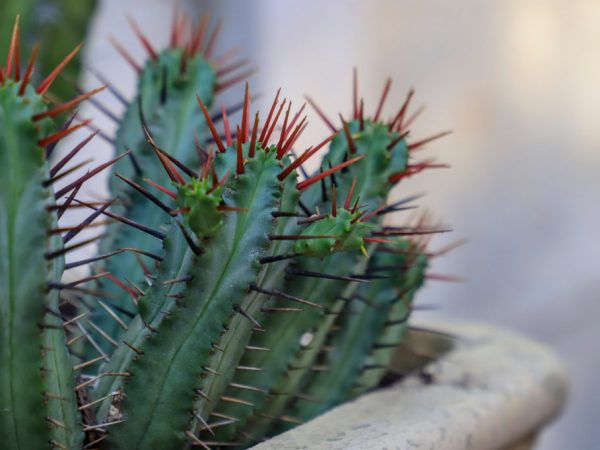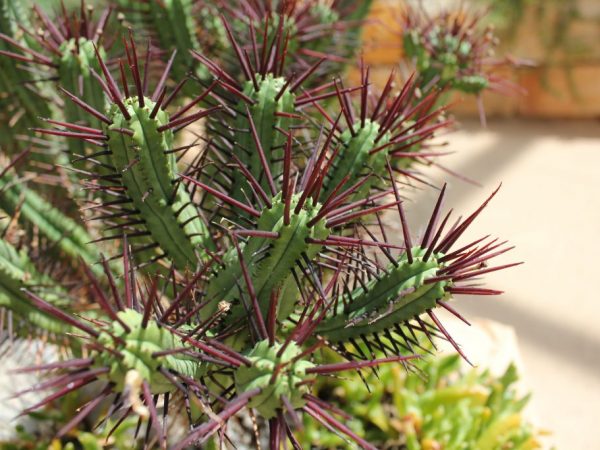Cultivation of Euphorbia Enoplus
Euphorbia Enopla is popular for its unpretentiousness and decorative appearance. This succulent is native to Africa, common in the Cape of Good Hope. Observing simple rules of care, this exotic plant can be grown at home.

Cultivation of Euphorbia Enoplus
Description
Euphorbia Enopla is a perennial spurge (very similar in appearance to a cactus). It is distinguished by strong branching of stems and long decorative needles.
It reaches a height of 30 to 120 cm. Stems are ribbed, green or bluish, with "cones". Violet-red thorns grow up to 4-6 cm.
Enopla is a dioecious succulent plant with male and female flowers on different plants. During flowering, it becomes even more interesting, since the yellowish flowers resemble the elongated eyes of a snail.
Its leaves are very small and fall off immediately. There is also a comb variety of this perennial.
Spurge contains poisonous juice that causes burns and irritation. When working with the plant, wear rubber gloves and goggles.
Purchase and adaptation
When purchasing a perennial, pay attention to the condition of the stems: are there any foreign spots, damage, soft areas. The needles of a healthy plant are firmly attached to the ribs. The roots should not be dry and sticking out of the drainage holes.
- For the first two weeks, place the succulent plant separately from other flowers, looking closely for signs of pests and diseases.
- Transplant the spurge no earlier than a month after purchase.
- Provide Enople with comfortable conditions: good lighting, regular watering, temperature conditions.
- If possible, do not disturb the plant (do not cut and feed, do not move the pot often, etc.) - let it calmly adapt to its new place of residence.
Growing conditions
Priming
Enopla grows well in universal soil for succulents. If you want to make a substrate yourself, mix slightly acidic leafy and sod soil with clean coarse sand (in equal proportions). You can add some charcoal or ash.
Lighting
This succulent prefers well-lit places. It is better to place it on the southern windowsills. In summer, the plant can be taken out into the bright sun, in winter - supplemented.
Temperature
This succulent is thermophilic and successfully withstands heat up to 30 ° C. However, in summer, it is better at 24-25 ° C. In winter, the optimum temperature is 16-17 ° С, but not lower than 12 ° С.
Home care

The plant needs a lot of light
Despite its exotic origin, the Enoplus euphorbia is unpretentious and not too demanding to care for. However, you need to know that in order to maintain decorativeness, it needs good lighting. When grown in the shade, the stems are very elongated and need props.
Watering and humidity
In spring and summer, the succulent is watered every 10 days, provided that the top layer of the earth is dry enough.Overflow for milkweed is much more dangerous than temporary drought. For irrigation, use settled soft water. In winter, procedures are carried out less frequently (once a month or even one and a half). Enopla is not demanding of air humidity.
Fertilizers
Mandatory feeding is carried out in the spring, using complex fertilizers for succulents. If desired, you can feed the euphorbia monthly (in the warm season), but dilute the recommended dose in half. Do not overfeed Enoplu with nitrogen - cracks may appear on the stems.
Transfer
Young specimens can be transplanted annually in the spring, and adults - once every three to four years.
The procedure is carried out in rubber gloves and goggles (so that the juice does not splash into the eyes when the stem is broken).
- Drainage from broken bricks is laid in a more spacious container, and then a layer of substrate for succulents.
- The plant is moved along with the lump, watered with lukewarm water, covered and tamped.
Reproduction
Euphorbia Enopla is usually propagated by cuttings.
A seed propagation method is also possible, but it is more laborious and is rarely used by amateur flower growers.
The tops of the shoots are cut off and placed in clean water to drain the poisonous juice. Then they are air-dried for 2-3 days. Places of cuts on the parent plant are treated with an antiseptic.
The cuttings are deepened into wet sand or perlite for rooting (you can preliminarily hold them in Kornevin). After a few months, when the roots appear, they are transplanted into the soil. Some growers successfully root shoots directly in the succulent substrate to avoid subsequent transplanting.
Diseases and pests
| Problem | Manifestations | Prevention measures | Treatment |
| Whitefly | First, white insects with wings appear, and then a black sooty mushroom. | Excessive watering and high air humidity are contraindicated. The room must be often ventilated, and the flower must be regularly inspected. | For catching whiteflies, sticky tapes are hung; The stems are washed with water and laundry soap. If the pests are not removed, the euphorbia must be treated with Fitoverm. |
| Mealybug | A fluffy bloom similar to cotton wool appears. You can see elongated whitish bugs. | The flower must be kept clean, wipe the intercostal space with a damp cloth, avoiding contamination. | Clean with a brush in soapy water or detergent; Process with Vermitic. |
| Mold | Fluffy white spots. | Moderate watering and maintaining a comfortable temperature. | Remove mold from the flower, remove the top layer of soil. In a serious case, transplant a succulent. Treat with fungicide. |
| Root rot | The stem darkens, softened areas appear. | Disinfection of the tool during pruning, proper watering, moderate fertilizing. | Cut off the damaged parts and transplant the euphorbia into a fresh substrate, after pretreating the soil and plant with Bordeaux liquid, colloidal sulfur or copper sulfate. |

